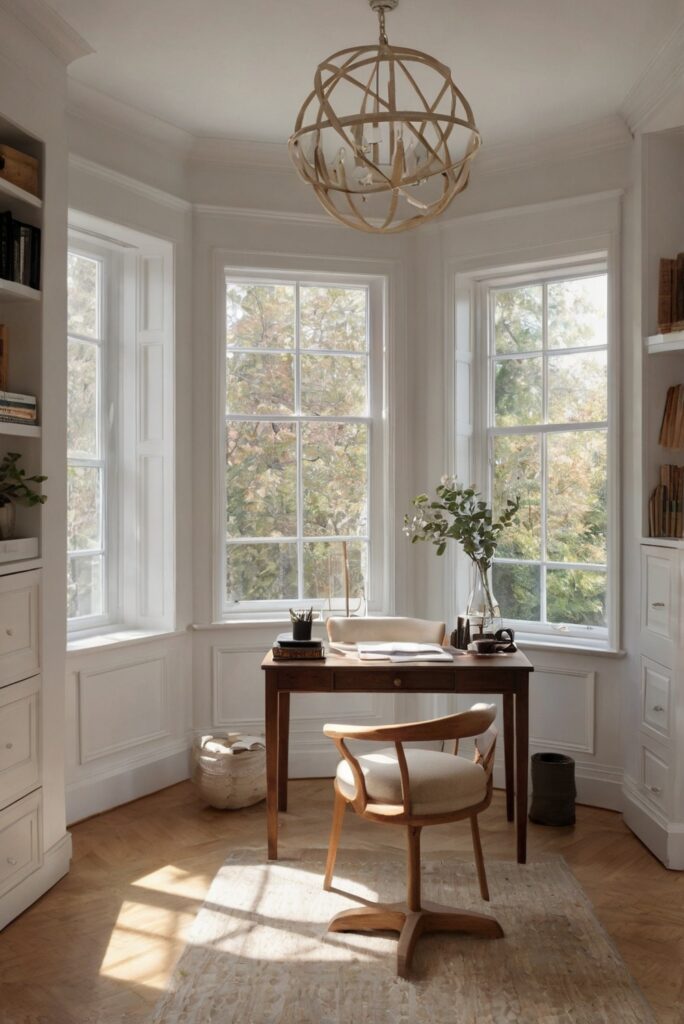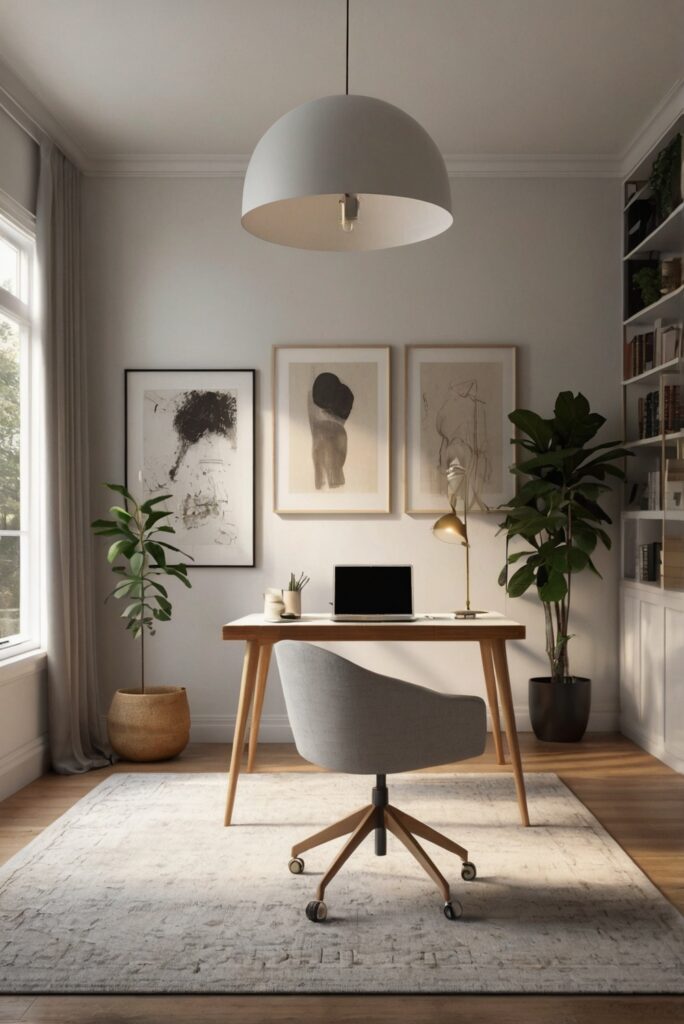Discover expert tips on incorporating natural light into your home office design for a brighter and more productive workspace.
How to Incorporate Natural Light into Your Home Office Design?
– Assess the natural light sources in your home office space to identify areas for improvement.
– Choose light-colored paint and decor to maximize the light’s reflection within the room.
– Consider adding large windows or skylights to increase the amount of natural light entering the space.
– Use sheer curtains or blinds that can be easily adjusted to control the amount of light entering the room.
Incorporating natural light into your home office design can boost productivity, mood, and overall well-being. It also reduces the reliance on artificial lighting, reducing energy costs and environmental impact. By strategically placing your work desk near a window or skylight, you can create a well-lit and pleasant workspace that enhances creativity and focus.
When designing your home office for natural light incorporation, it’s crucial to consider the function of the room and the placement of furniture to maximize both light and functionality.Floating the furniture away from the walls and clustering it around the light source can create a more open and inviting space. Adequate lighting is essential for the proper execution of tasks and can affect your mood and productivity.
Why is natural light important in a home office?
Natural light plays a crucial role in creating a productive and comfortable workspace. It has been proven to boost mood, energy levels, and overall well-being. Exposure to natural light helps regulate our circadian rhythm, which in turn can improve sleep patterns and overall health. Additionally, natural light can reduce eye strain and headaches that may result from harsh artificial lighting. By incorporating natural light into your home office design, you can create a more inviting and inspiring environment that promotes creativity and focus.
How can you maximize natural light in your home office?
To maximize natural light in your home office, consider the following strategies:
– Position your desk near a window to take advantage of direct sunlight.
– Use light-colored or sheer curtains that allow natural light to filter through.
– Keep windows clean to prevent any obstructions to sunlight.
– Opt for light-colored walls and furniture to reflect natural light and brighten the space.
– Use mirrors strategically to bounce light around the room.
– Consider installing skylights or light tubes for additional natural light sources.
By implementing these strategies, you can make the most of natural light in your home office and create a space that is both functional and aesthetically pleasing.
What are the benefits of incorporating natural light into your home office design?
Incorporating natural light into your home office design offers several benefits, including:
– Improved mood and productivity: Natural light can enhance mood, increase energy levels, and boost productivity.
– Health benefits: Exposure to natural light can regulate sleep patterns, reduce eye strain, and improve overall well-being.
– Cost savings: By relying more on natural light, you can reduce the need for artificial lighting and lower your energy bills.
– Aesthetic appeal: Natural light can enhance the aesthetics of your home office, creating a welcoming and inspiring environment.
By reaping these benefits, you can create a home office that is conducive to work and promotes a healthy work-life balance.
What are some practical ways to incorporate natural light into your home office design?
When designing your home office to incorporate natural light, consider the following practical ways:
– Choose a room with ample windows or consider adding windows if possible.
– Opt for window treatments that allow natural light to filter through while still providing privacy.
– Position your desk near a window to maximize natural light exposure.
– Use light-colored paint, furniture, and decor to reflect natural light and brighten the space.
– Incorporate plants near windows to bring a touch of nature and enhance the overall ambiance.
By following these practical tips, you can create a well-lit and inviting home office that promotes productivity and well-being.
What are the key considerations when incorporating natural light into your home office design?
When incorporating natural light into your home office design, it is important to consider the following key factors:
– Direction of sunlight: Position your desk and work area in a way that minimizes glare and maximizes natural light exposure.
– Window treatments: Choose window treatments that strike a balance between allowing natural light in and providing privacy and glare control.
– Artificial lighting: Supplement natural light with task lighting or overhead lighting for cloudy days or evening work sessions.
– Temperature control: Consider how natural light may impact the temperature in your home office and plan accordingly with proper insulation or ventilation.
By taking these key considerations into account, you can design a home office that optimizes natural light for a comfortable and productive workspace.
1. Why is natural light important in a home office design?
Natural light is essential in a home office design as it helps improve productivity, mood, and overall well-being. Natural light can reduce eye strain, increase focus, and boost energy levels, making it easier to work efficiently. Studies have shown that exposure to natural light can also regulate the body’s circadian rhythms, leading to better sleep patterns and overall health.
2. What are some ways to incorporate natural light into a home office design?
There are several ways to incorporate natural light into a home office design. One popular method is to position the desk near a window to maximize natural light exposure. Using light-colored furniture and walls can also help reflect and amplify natural light. Additionally, installing sheer curtains or blinds can control the amount of light entering the space while still allowing for a bright and airy atmosphere.
3. How can the layout of a home office impact natural light?
The layout of a home office can significantly impact the amount of natural light that enters the space. Placing furniture strategically to avoid blocking windows or creating shadows can help maximize natural light. Consider using glass partitions or doors to allow light to flow freely throughout the room. It’s also important to consider the direction of the windows and how sunlight moves throughout the day when designing the layout of a home office.
4. Are there any specific design elements that can enhance natural light in a home office?
Incorporating reflective surfaces such as mirrors, glass, or metallic finishes can help bounce natural light around the room and create a brighter environment. Choosing light-colored flooring, such as hardwood or light-colored carpet, can also help reflect light and create a more spacious feel. Additionally, adding plants or greenery near windows can not only enhance natural light but also improve air quality and create a more inviting workspace.
5. What are some common mistakes to avoid when incorporating natural light into a home office design?
One common mistake to avoid is relying solely on natural light without considering additional lighting sources for overcast days or evenings. It’s important to have a good balance of natural and artificial lighting to ensure a well-lit workspace at all times. Another mistake is neglecting window treatments, which can lead to glare, heat, or privacy issues. Choosing the right window coverings that allow for flexibility in controlling light levels is crucial when incorporating natural light into a home office design.



